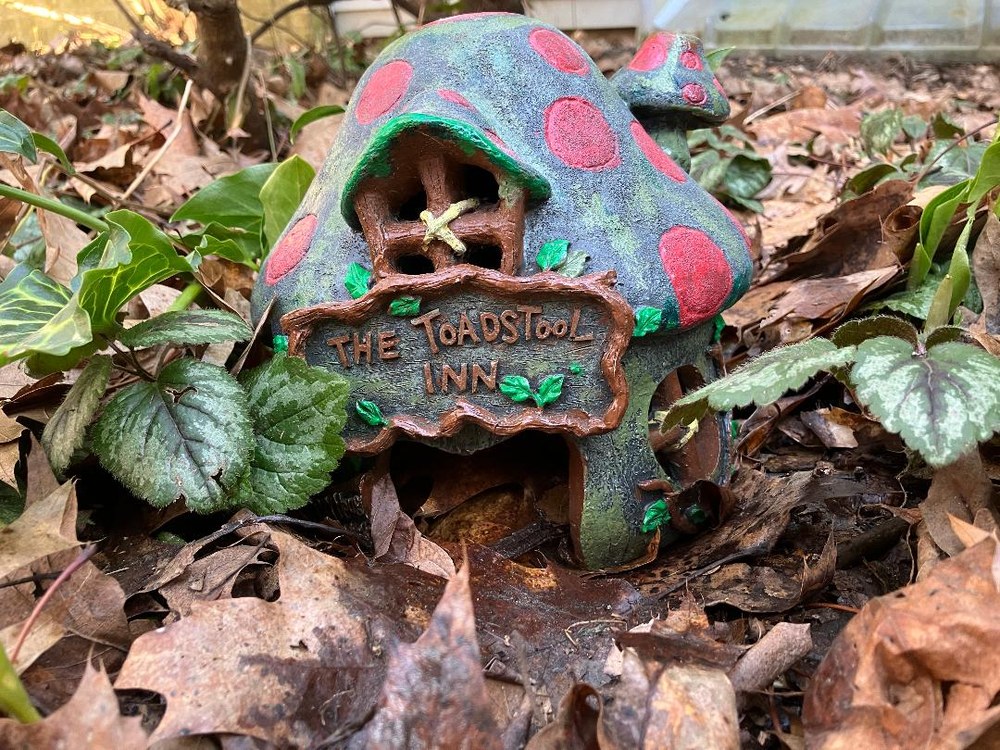Posted: May 12, 2025
Have you ever encountered a toad in your garden? No, not a loathsome, contemptible person, but a small bumpy-skinned creature who hops around devouring garden pests. Toads make wonderful garden partners by eating lots of grubs, slugs, snails and also many insects.

A toad abode—a simple shelter is inviting.
The most common toad found in our area is the eastern American toad (Anaxyrus americanus). Their dry, rough, and bumpy skin comes in various shades of brown, gray, or olive with dark brown or black spots. Adults are 2 to 4 inches long. Females have white throats and are slightly larger than males. They are often called "hoptoads" because they clumsily "hop" when they move instead of gracefully "leaping" as frogs do. In addition to camouflage, all toads produce toxic secretions from skin glands, which effectively deter predators, including cats and dogs. Touching a toad will not give you warts, but their skin secretions do irritate mucous membranes. If you handle a toad, wash your hands before touching your mouth or eyes.
It's easy to create a hospitable environment to attract toads to take up residence in your garden. With food, moisture, and shelter, they may remain in your garden for many years. Food sources are supplied by the various insect pests found in every garden. Toads also enjoy slugs, snails, centipedes, millipedes, and earthworms. Toads often sit near outdoor lights, waiting for insects. They actively hunt during the evening and on rainy or humid nights. Consider placing a small solar-powered light in a garden bed with dense, low-growing foliage. The light will attract flying insects, providing an easy food source to entice toads.
Allow some leaf litter to accumulate under your trees and shrubs and in your flower beds. Natural leaf mulch provides the cool environment that is ideal for a toad. Dense plantings of perennials and groundcovers provide both hideouts and hunting grounds. Leaf litter also offers suitable areas for hibernation.
Curb your use of pesticides. Toads have permeable skin, which allows pesticides and pollutants to pass through and into their bodies. These chemicals disrupt development and reproduction and even kill toads. In fact, frogs and toads are considered indicators of environmental health.
While a small garden pond is ideal for toads, a simple moisture source can be made by placing a shallow container of water in a quiet, shady spot. The container should be slightly recessed into the ground so that a toad may easily hop into and out of it. Toads absorb water through their skin, so it's important to keep the container filled with clean water, especially on hot days.
Toads are most active at night. During the heat of the day, they seek shelter and moisture. They cover themselves in damp mulch or hide beneath low plants. It's easy to create a toad home by using an old clay flowerpot. Turn the pot over and prop it up on one side with a few stones to create an entrance for the toad. A simple toad shelter may also be made by building a small rock pile in a quiet, shady corner of your garden. Leave a space between the rocks and the ground for the toad to snuggle. You can also buy decorative "toad abodes" in many lawn and garden centers.
By providing these basic necessities, a toad may become your long-time gardening partner, helping your garden to flourish and adding to its natural diversity.
For additional information about the Eastern American Toad:
- PAHerp, Eastern American Toad
- New Jersey Department of Fish & Wildlife, American Toad Fact Sheet (PDF)
Barbara Murphy is a Penn State Master Gardener. This volunteer program supports the outreach mission of Penn State Extension and provides research-based information on best practices in sustainable horticulture and environmental stewardship. For more information, contact the Penn State Extension of Allegheny County at alleghenymg@psu.edu or 412-482-3476.

